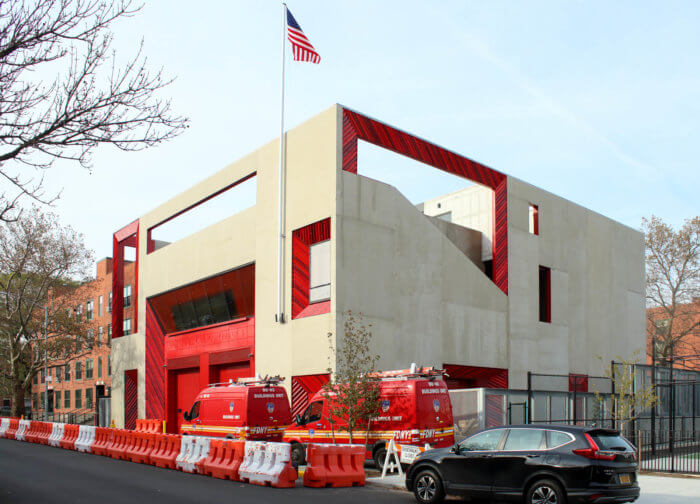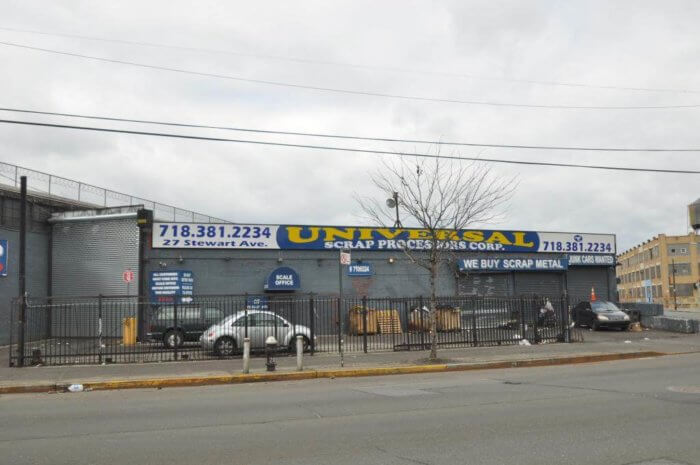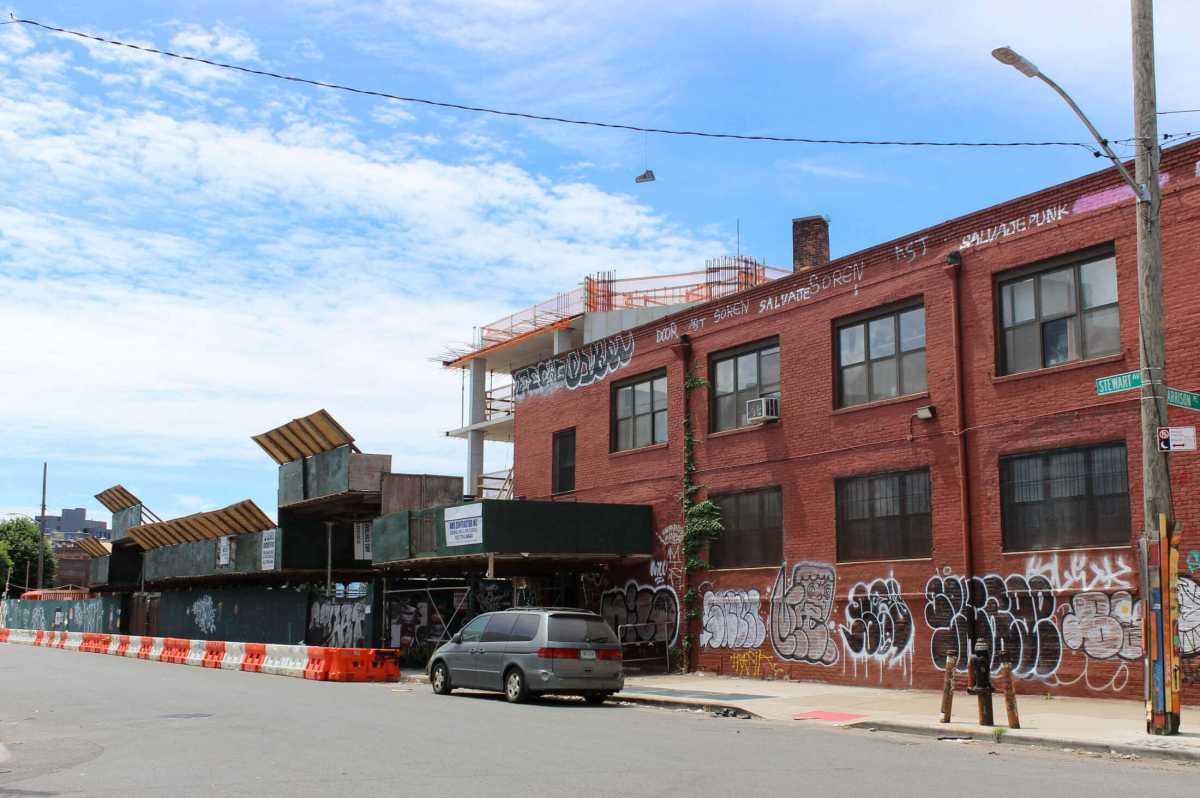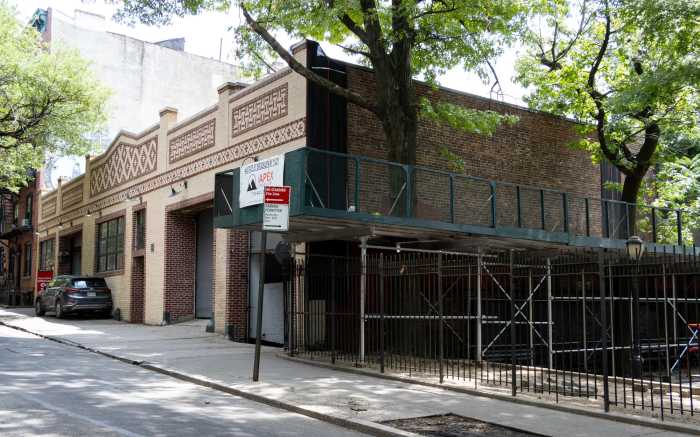The once-derelict lot at 27 Stewart Avenue in Bushwick had been earmarked for a nine-story hotel since plans were filed in 2015, but with little to no progress in the past seven years, the site — also a brownfield — instead turned into a local dumping ground.
But since late 2021, neighbors would have noticed activity around the 42,166-square-foot lot after it was purchased by 25c LLC for $12.271 million in October.
Now, the plans for a hotel are back up and running, with brownfield remediation under way and foundations going in the ground, according to the architect for the project, Nick Liberis of Archimaera (formerly Albo Liberis LLC), who says the former manufacturing site is set to become New York City’s first geothermal powered hotel.
Liberis and the team are currently waiting on the city’s Board of Standards and Appeals to approve the project’s continuation, following a December 2021 zoning text amendment that requires proposed new hotels in protected manufacturing districts to go through a public review process rather than be built as of right.
The new owners argue that they have acquired “a common law vested right to complete construction of a substantially completed eight-story hotel,” in the words of the community board’s meeting minutes, and would suffer millions in losses and be forced to sell the property if the hotel is not allowed. According to a statement of facts filed with the BSA, the new owners have completed 84 percent of the site’s excavation, laid 74 percent of the foundation and spent $6 million of the project’s estimated total $36 million. Community Board 1 voted in May to recommend that the BSA renew the permit, and BSA will hold a public hearing on September 12.
In 2015, former owners James and Louis Ruggiero, who owned the frying pan-shaped site since at least 2004, filed an application for a permit to build the nine-story, 140-room hotel. A new-building permit was issued in 2017.
In 2019, with no development on the horizon, an entity linked to developer Yoel Goldman bought the property for $14.3 million. Then, just two years later, the group sold it to 25c LLC. According to city records, the entity is linked to Bushwack Capital, which owns commercial properties in the neighborhood, including one that was leased by a pop-up nightclub in 2015 that garnered noise complaints (the building now houses Vietnamese restaurant Bunker and the head office for grocery delivery service Natoora).

The updated plan for the 27 Stewart Avenue site is for a 96,000-square-foot, eight-story hotel that includes around 160 rooms, a rooftop pool, a restaurant and a health and wellness facility. Heating, cooling and hot water will be supplied by a geothermal loop.
Liberis, who was involved with the project prior to the LLC’s purchase and is behind the green architecture that will form the basis of the structure, told Brownstoner the aim is to reduce the energy usage of the entire building, starting right at construction — which includes sourcing materials from as close to the site as possible. Liberis has worked on other hotel projects nearby, including the William Vale Hotel and Williamsburg Hotel.
Geothermal uptake slow in New York City
Geothermal heating and cooling is thought to be a highly efficient, renewable and clean technology that has been available for decades, but is uncommon in New York City. Currently only a few buildings in the city are using the resource, including Bronx River House and the Studio Gang-designed firehouse in Brownsville. Instead of using fuel, geothermal systems use the heat below the earth’s surface to heat and cool buildings and generate electricity.
In 2021, then-mayor Bill de Blasio pursued plans to increase geothermal use in the city, saying it could help replace fuel oil and natural gas. Ben Furnas, director of the Mayor’s Office of Climate and Sustainability, said at the time geothermal technologies “will play a key role in providing clean, affordable, and comfortable homes and workplaces while accelerating our transition away from fossil fuels.”
Despite the push — and numerous incentives such as tax breaks and grants for installing geothermal — uptake in New York City has been slow. Bob Nowak, executive director of trade organization NY Geo, puts that down to people going with what they know (gas), as well as gas being long-favored and incentivized by the city. He also added the upfront costs that come with geothermal installation can be a deterrent.
Nowak said although he has noticed an uptick in geothermal adoption across the state it needs to become the norm, saying “we are killing ourselves to heat ourselves and our buildings.” He added that using fossil fuel powered heating and cooling is becoming “unnecessary and obsolete,” and he predicted fossil fuels, such as gas, would only continue to rise in price.
Nonetheless, practical barriers to its implementation remain in New York City, according to Richard Yancey, executive director of Building Energy Exchange. Yancey said a major part of the problem with implementing geothermal in New York City is real estate — or the lack thereof. Given both residential and commercial lots are often tightly packed with buildings, there isn’t much space to drill bore holes and insert geothermal piping.

However, Yancey said there is hope on the horizon for inner city homeowners with the development of equipment that can fit into cellars and drill geothermal bore holes straight from the cellar floor. He also noted some exciting developments in geothermal use across the city, including a new building in Hudson Yards — 555 Greenwich — which will have geothermal pipes running through its pilings.
Space isn’t the only issue with the installation of geothermal systems, as the team behind the hotel knows: The ground also has to be in good condition. Part of the Stewart Avenue site is contaminated by oil due to it once housing a gas station, automotive repair shop and a vehicle dismantling facility. The current owners started remediation in conjunction with New York State Department of Environmental Conservation. A rep from DEC told Brownstoner the cleanup includes remedial efforts to address petroleum releases from the gas station.
However, contamination remains, and that is being addressed by the new owners as part of the state’s Brownfield Cleanup Program. “DEC oversees the program to ensure work at the site is protective of public health and the environment,” the rep said. Liberis said an oil spill at the front of the section makes up the worst of the contamination, and the plan is to clear it by mid July. Remediation work can continue while the team waits on the BSA’s decision, he added.
In regards to the geothermal well drilling, DEC said it hadn’t received plans for the wells proposed at the site, and said they could not interfere with ongoing remedial work. However, Liberis said the contamination doesn’t pose an issue for the geothermal drilling, as the wells will be drilled in the uncontaminated frying pan handle section of the site. (Water used for drinking and bathing will of course come from the city water supply, not the closed-loop geothermal system.) Regardless, Liberis said before starting the drilling, the team needs DEC, DOB and MTA approval (because the site is close to the L train).
Reducing energy use comes down to planning, urban design
The geothermal energy at the Bushwick hotel will come from around 60 bore holes that will go around 300 to 500 feet deep and contain the geothermal pipes. Those pipes will all connect to a larger pipe that then runs to heat pumps in the hotel, creating a geothermal loop, Liberis said.
The closed loop uses the constant heat of the water underground (which stays at around 55 degrees year-round) for cooling in summer and heating in winter by conducting a heat transfer through the geothermal pipes and heat pumps. In summer, heat is pulled from hot air in the hotel and transferred into the ground to cool the hotel. In winter, heat is drawn from the ground to warm the hotel.
Both Nowak and Yancey commended the hotel’s plans, saying the more big projects that are built using the energy source the better. Nowak said although 60 bore holes sounds like a lot to be drilling, there are many other projects that use a lot more. Yancey added that the plan sounds ambitious and forward thinking and said anyone building with geothermal is on the leading edge of energy efficiency.
Liberis said the first principle of any eco conscious or sustainable design is to reduce energy usage to the absolute minimum. A key part of that is super insulating the building, which Liberis said includes using triple-pane glass. “The type of glass is on par with what the energy code allowed for an actual wall only as far back as 2007,” he noted.
The team is also planning to use coal ash to fortify the concrete in the building rather than usual methods, such as using Portland cement, which Liberis said have a much larger carbon footprint. According to the Environmental Protection Agency, recycling coal ash, which is encapsulated in the concrete, locking toxic contaminants inside, has positive environmental, economic and performance benefits.
“There’s all sorts of ways that you can pick and pop and we’re trying to do all of that here,” Liberis said of the eco conscious design. “But ultimately the green question is a much bigger question, not just building function, but a bigger urbanistic concept.”
He said basic planning is core to green design, and in New York that just isn’t happening efficiently with the huge number of residential buildings and few buildings providing services. In order to build more sustainable communities, he touted the concept of the 15-minute city where everything you need is within 15 minutes reach, akin to smaller villages or towns within bigger city areas.
“That should be the goal planning-wise, not totally enclosed but totally self-sufficient pieces of the city,” he said. In this particular location in Bushwick, the hotel would be part of that — bringing services into the area that currently do not exist and catering to current demand for tourism and health care facilities. Developments like this should also be occurring in other communities with fewer resources, such as East New York, to bring in needed services, he said. “There is no reason why they cannot both exist.”
A community health facility to center the hotel
One of the building’s owners, who asked not to be named, told Brownstoner that while the team is still figuring out the details of the health and wellness community facility, it would likely include physical therapy, neural feedback, different types of massage therapy, acupuncture and other treatments — “they have to be practitioners that are licensed by the state of New York,” he said.
The owner said that through his other manufacturing and event spaces in the neighborhood he knows a number of tenants and small businesses that would like to be included in the health hub at the hotel, which will be open for the public to use.
“We want to do things that benefit the community and benefit the area, but are not always economically viable, so we are trying to do creative things to figure out a sustainable financial model,” he said. He added the hotel is a long term investment and the team expects the first few years to be tough financially, but said they are determined to make it work. And, he added, there are no plans to convert the building into a homeless shelter, as sometimes happens with hotels in commercial and industrial areas.
The developer’s aim with investing and developing — which he does primarily in Bushwick — is building spaces for businesses and events that are accessible to the community and help to build a creative local ecosystem, he said. In regards to the hotel, he said the site had been an eyesore for years and he wants to turn it into a place that will draw people to the area, “not what people are expecting with an outer borough hotel, which are often just like rural Holiday Inns.”

He said he hopes locals see the value of the new hotel and healthcare facility to the Bushwick community, adding that he wants to create “interesting developments and projects that maintain the essence of what was there, the industrial stuff and the gritty New York,” which he said neighborhoods that had been through development booms, such as Williamsburg, are lacking.
Nearby Williamsburg has seen something of a hotel boom in recent years. In Bushwick, Heritage Equity Partners planned to build the Bushwick Hotel at 232 Seigel Street but construction has not started and the site is in litigation, The Real Deal has reported.
A typical mid-size apartment building using standard building technologies could take a year or two to build after permits are issued, assuming all goes smoothly. A small portion of the hotel at 27 Stewart Avenue has already risen three stories.
The developer said he expects the hotel to open by the end of next year, and Liberis seconded that timeline.
This story first appeared on Brownstoner.

























